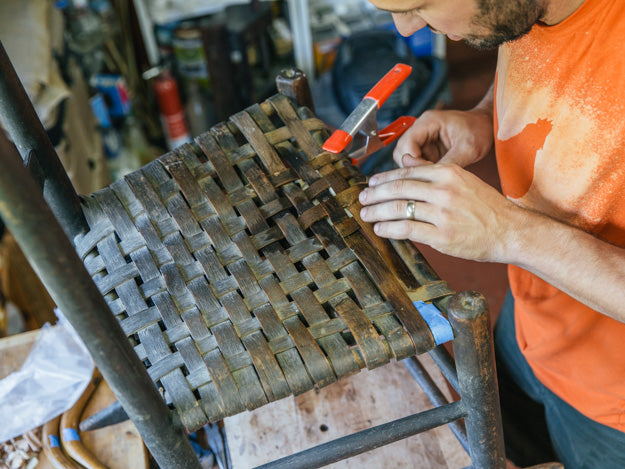I've been doing my best to hold down the fort around here while Joshua was away at Woodworking in America. In the weeks before he left, we'd received a disproportionate number of chairs to be reglued, recaned, or otherwise repaired. At one point I think I counted 16 in the studio, surely a new record (if anyone is keeping score). One chair I worked on recently I've affectionately dubbed "Little Abe Lincoln's Rocker": a pretty 19th-century child's chair with a woven hickory-splint seat. The seat appears to be original, but the splints had unfortunately been broken all across the front. Our goal with this project was to restore the appearance of the chair without resorting to using new materials - we planned to reuse as many of the broken splint pieces as we could and scavenge whatever else we needed from the underside of the seat. Easier said than done!

My first step was to map out the plan of attack. The first three side-to-side splints needed to be replaced, as well as sections of all eight front-to-back splints. Joshua and I decided that it was acceptable to glue splint pieces together on the undersides of intersections in the weave, keeping these new joints hidden while creating at least aesthetic structural integrity (No, don't let the kids sit on this one!). After planning out these intersections, I carefully cut out all the broken pieces of splint at the necessary intervals. It's a bit nerve-racking to slice through centuries-old bits of hickory, especially knowing that my available material for this repair was extremely limited.

I then began fitting the pieces in their new locations. Each splint was soaked in very hot water and worked carefully until it became pliable enough to bend into the weave and around the rungs. Amazingly, the hickory didn't flinch with this treatment - it behaved beautifully! Wood is incredible stuff.
After everything dried, I carefully pulled things apart just enough to sneak some hide glue in the joints, then reclamped and moved on to another project (yep, a chair) for the rest of the day.

Once the clamps came off, the final step was evening out the color across the whole seat. The pieces I'd scarfed in had spent the last few hundred years or so on the underside of the seat, receiving little wear or patination, while the rest of the hickory had supported the squirmings of generations of little rascals (and maybe, future presidents). I applied several layers of dye to the restored areas, carefully scraped down edges to duplicate wear patterns, and padded shellac over the whole surface. Finally, some dark wax gently buffed on with #0000 steel wool evened out the gloss.

Joshua rolled back into town last night, er, this morning, so we will be unpacking the van and getting caught up tomorrow. Watch for his WIA musings soon! It sounds like it was an awesome event. Also, check out our Apprenticeship Series: The Foundations video, available in several formats. We think you'll love it!

